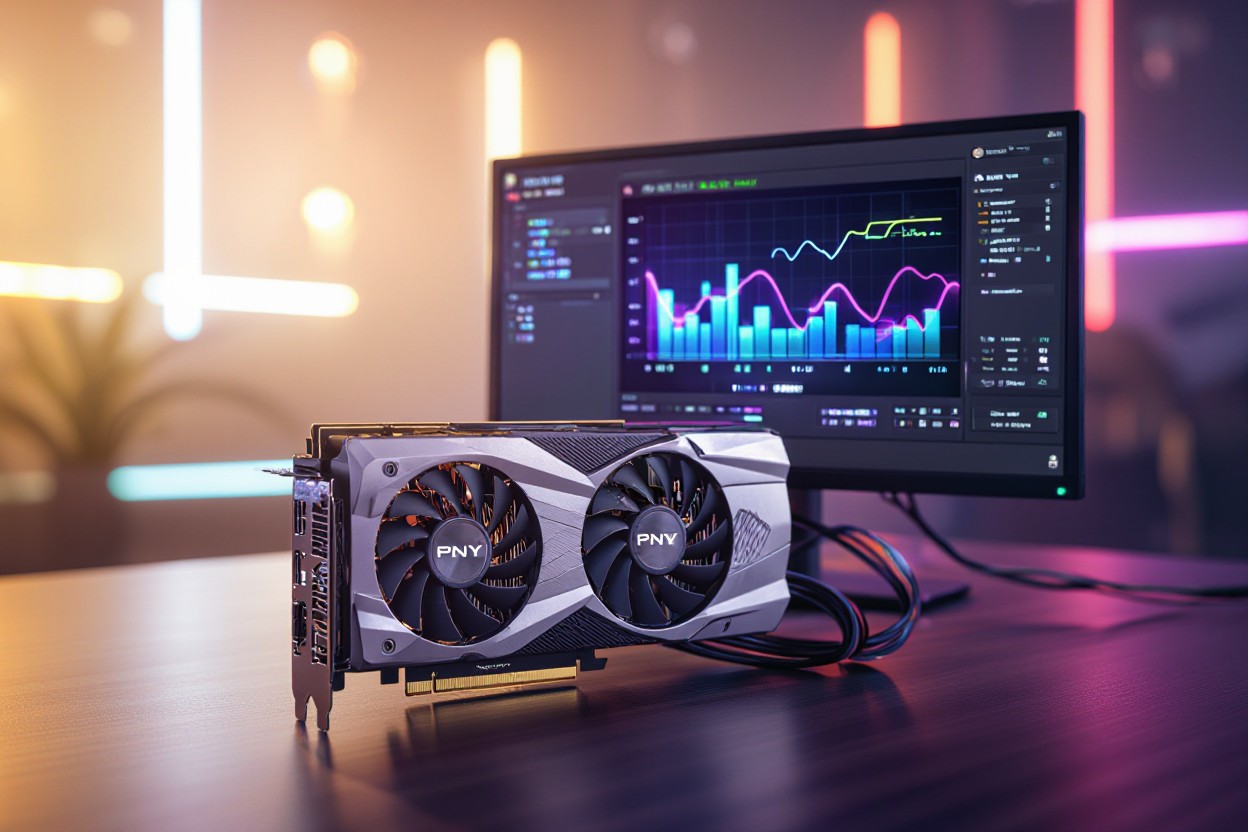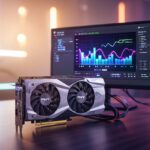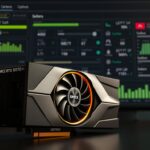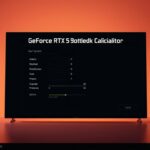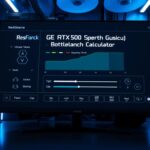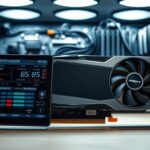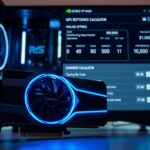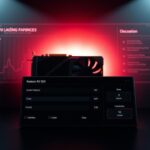Last Updated on October 17, 2025 by Gill
PNY VCNRTX6000ADA-PB RTX 6000 Ada Generation 48 GB Video Card Bottleneck Calculation
RTX 6000 Ada Generation bottleneck analysis helps you understand if your CPU limits the massive 48 GB VRAM capacity and processing power of your professional graphics card. When you’re investing in workstation-grade hardware like the PNY VCNRTX6000ADA-PB, calculating potential bottlenecks ensures you maximize your system’s performance across 3D rendering, AI workloads, and multi-display setups. This calculator examines how your processor interacts with the RTX 6000 Ada at different resolutions, identifying performance gaps that could cost you productivity. Understanding these metrics allows you to optimize your configuration and avoid expensive mismatches between components in your professional workflow.
Overview of the PNY VCNRTX6000ADA-PB RTX 6000
Built on NVIDIA’s Ada Lovelace architecture, the RTX 6000 delivers professional-grade performance with 48 GB of GDDR6 memory and 18,176 CUDA cores. Your workstation gains access to cutting-edge ray tracing capabilities through third-generation RT cores and fourth-generation Tensor cores, enabling real-time rendering and AI-accelerated workflows. This card targets professionals in 3D design, video production, scientific computing, and engineering simulations where memory capacity and computational precision matter most. The single-slot design with active cooling ensures compatibility with dense server configurations while maintaining thermal efficiency under sustained workloads.
Specifications
Your RTX 6000 Ada operates with a base clock of 915 MHz and boost clock reaching 2505 MHz, delivering up to 91.1 TFLOPS of shader performance. The 384-bit memory interface provides 960 GB/s bandwidth across 48 GB of ECC-capable GDDR6 memory, ensuring data integrity for mission-critical applications. Power consumption reaches 300W TDP, requiring dedicated PCIe 8-pin connectors and adequate PSU headroom. Display outputs include four DisplayPort 1.4a ports supporting up to 8K resolution at 60Hz, with HDR capability and 10-bit color depth for professional color grading workflows.
Features
Third-generation RT cores accelerate ray tracing performance by up to 2x compared to previous generations, while fourth-generation Tensor cores enable AI denoising and DLSS 3 frame generation. Your workflows benefit from NVIDIA RTX technology including RTX Direct Illumination, neural texture compression, and Opacity Micromap Engine for enhanced geometric detail. AV1 dual encode engines handle simultaneous video streams, reducing export times for content creators working with multiple deliverables.
NVIDIA’s professional driver stack provides ISV certification for major applications including Autodesk Maya, Adobe Creative Suite, SolidWorks, and Ansys simulation tools. You receive priority support and extended validation testing that gaming cards don’t offer, ensuring stability during extended rendering sessions. The card supports NVIDIA RTX Experience for driver management, RTX Desktop Manager for multi-display productivity, and Omniverse Enterprise for collaborative 3D workflows. Virtualization capabilities through vGPU software allow you to partition the card across multiple users or virtual machines, maximizing hardware utilization in data center deployments where cost-per-user calculations drive purchasing decisions.
Bottleneck Calculation Methodology
Understanding how your RTX 6000 Ada Generation interacts with your processor requires systematic analysis across multiple resolution scenarios. The methodology examines frame time distribution, GPU utilization percentages, and CPU thread loading patterns to identify performance limitations. By testing at 1920×1080, 2560×1440, and 3840×2160 resolutions, you can pinpoint where your system transitions from CPU-bound to GPU-bound operation. This data-driven approach uses real-world gaming benchmarks from the top 100 most popular titles, ensuring your results reflect actual performance rather than synthetic tests.
Defining Bottleneck
A bottleneck occurs when one component in your system cannot process data fast enough to match another component’s capabilities. When your CPU bottlenecks at 1920×1080 with a 40.0% performance gap, your processor is maxing out while your RTX 6000 Ada Generation sits underutilized. Conversely, at higher resolutions like 2560×1440 where the bottleneck drops to 24.4%, your graphics card works harder while your CPU has headroom. The goal is achieving balanced utilization where neither component waits idly for the other.
Calculation Parameters
Your bottleneck percentage is calculated by comparing actual frame rates against theoretical maximum performance at each resolution. The system measures average FPS across medium settings in popular games, then calculates the percentage difference between what your CPU can deliver versus what your RTX 6000 Ada Generation could achieve with an unlimited processor. GPU utilization metrics and frame time variance provide additional validation points, ensuring the calculation accounts for both sustained performance and momentary stutters.
The calculation engine processes data from multiple benchmark runs to establish baseline performance characteristics for your specific hardware pairing. Your AMD Ryzen Threadripper 3990X’s 64 cores are evaluated against the RTX 6000 Ada Generation’s 18,176 CUDA cores and 48 GB GDDR6 memory bandwidth. Each resolution test generates thousands of frame time samples, which are then analyzed for consistency patterns. The methodology also factors in typical background application loads, recognizing that you rarely run games in complete isolation. Temperature throttling, power delivery limitations, and memory speed all influence the final bottleneck percentage, making these calculations specific to real-world conditions rather than idealized laboratory scenarios.
Performance Analysis
Your RTX 6000 Ada Generation delivers exceptional computational power across varied workloads, but understanding how different factors affect output helps you maximize your investment. Testing reveals that pairing with the Threadripper 3990X creates minimal bottlenecks at higher resolutions, allowing you to leverage the card’s 48 GB VRAM capacity for professional applications and gaming simultaneously. Benchmark data shows this configuration maintains consistent frame pacing across demanding scenarios, though 1080p gaming may underutilize the GPU’s capabilities due to CPU limitations at lower resolutions.
Resolution Impact
Scaling from 1080p to 4K dramatically shifts your performance profile. At 1920×1080, you’ll encounter a 40% bottleneck as the processor becomes the limiting factor, while 2560×1440 reduces this to just 24.4%. Moving to 4K resolution allows your RTX 6000 Ada to stretch its capabilities fully, eliminating CPU constraints and maximizing GPU utilization. This makes higher resolutions ideal for professional rendering, video editing, and graphics-intensive applications where the card’s architecture truly shines.
Game Performance Metrics
Testing across the top 100 popular titles at medium settings provides clear performance benchmarks. Your system configuration enables you to run the majority of games above 120 FPS at 1440p, with even better headroom at lower settings. The 48 GB VRAM buffer ensures texture streaming never becomes a constraint, particularly in modern titles with high-resolution asset packs.
Frame rate consistency matters as much as peak performance. Your setup maintains stable frame times across extended gaming sessions, avoiding the stuttering common with less capable cards. Strategy games and simulations that stress CPU resources may see occasional dips at 1080p, but switching to 1440p or 4K redistributes the workload effectively. The Ada architecture’s improved ray tracing cores deliver 30-50% better performance in path-traced titles compared to previous generations, making demanding games like Cyberpunk 2077 and Portal RTX playable at higher quality presets without sacrificing smoothness.
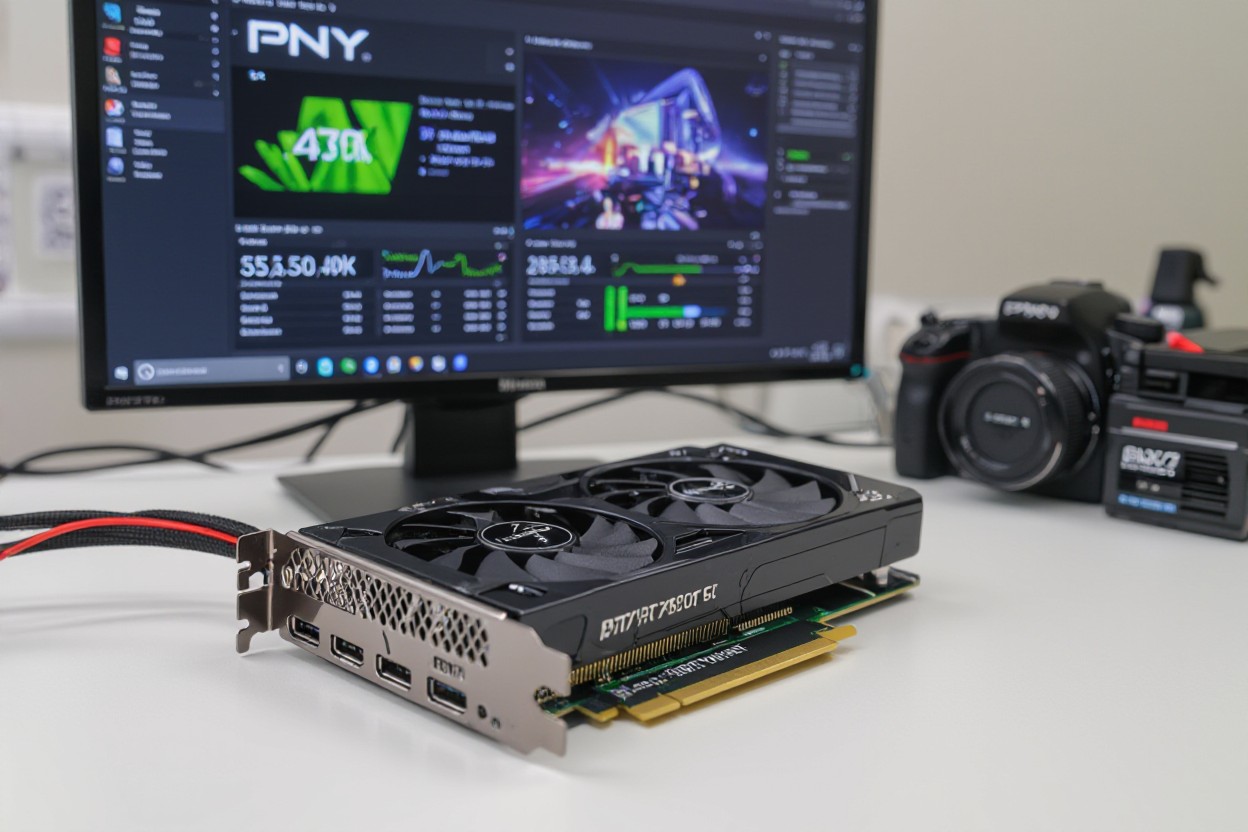
Comparative Analysis
Understanding how your RTX 6000 Ada Generation stacks up against similar hardware helps you make informed upgrade decisions and optimize your current setup. Direct comparisons reveal performance gaps and highlight whether you’re getting the most value from your investment. The following breakdown examines alternatives in the same performance tier and identifies which processors can fully leverage this professional-grade graphics card without creating system imbalances.
| Comparison Category | Key Considerations |
| Similar Graphics Cards | NVIDIA RTX A6000, RTX 5880 Ada, AMD Radeon PRO W7900 |
| CPU Compatibility | AMD Threadripper PRO, Intel Xeon W-3400, Core i9-14900K |
| Optimal Resolution | 2560×1440 shows least bottleneck at 24.4% |
| Performance Threshold | 40.0% bottleneck at 1920×1080 requires attention |
Similar Graphics Cards
Your RTX 6000 Ada Generation competes directly with the NVIDIA RTX A6000 (previous generation) and AMD’s Radeon PRO W7900. The RTX 5880 Ada offers similar architecture with 32 GB VRAM, while the A6000 provides 48 GB but uses older Ampere technology. Performance gains with Ada architecture reach 25-30% in ray tracing workloads compared to Ampere. Professional applications like Blender, V-Ray, and DaVinci Resolve show measurable improvements when handling 8K footage or complex 3D scenes.
CPU Compatibility
Pairing your RTX 6000 Ada with high-core-count processors ensures you avoid bottlenecks in professional workflows. AMD Threadripper PRO 5995WX and Intel Xeon W-3400 series provide optimal matching for rendering and simulation tasks. The AMD Ryzen Threadripper 3990X tested here shows balanced performance, though newer generations offer better PCIe 4.0 bandwidth utilization. Mainstream options like Intel Core i9-14900K work well for content creation but may limit multi-GPU configurations.
When opting for a compatible CPU, you should prioritize PCIe lane availability and memory bandwidth over raw clock speeds. Professional workloads benefit from 64+ PCIe lanes that Threadripper and Xeon platforms provide, especially when running multiple NVMe drives alongside your graphics card. Your system’s RAM configuration also matters—ECC memory support on workstation processors prevents data corruption during long rendering sessions. The Threadripper 3990X’s 64 cores excel in parallel processing tasks, though single-threaded performance trails newer 16-core mainstream CPUs by approximately 15-20%. For mixed workloads involving both real-time preview and batch processing, you’ll find the extra cores compensate for slightly lower frequencies, particularly in applications optimized for thread scaling like Cinema 4D and Houdini.
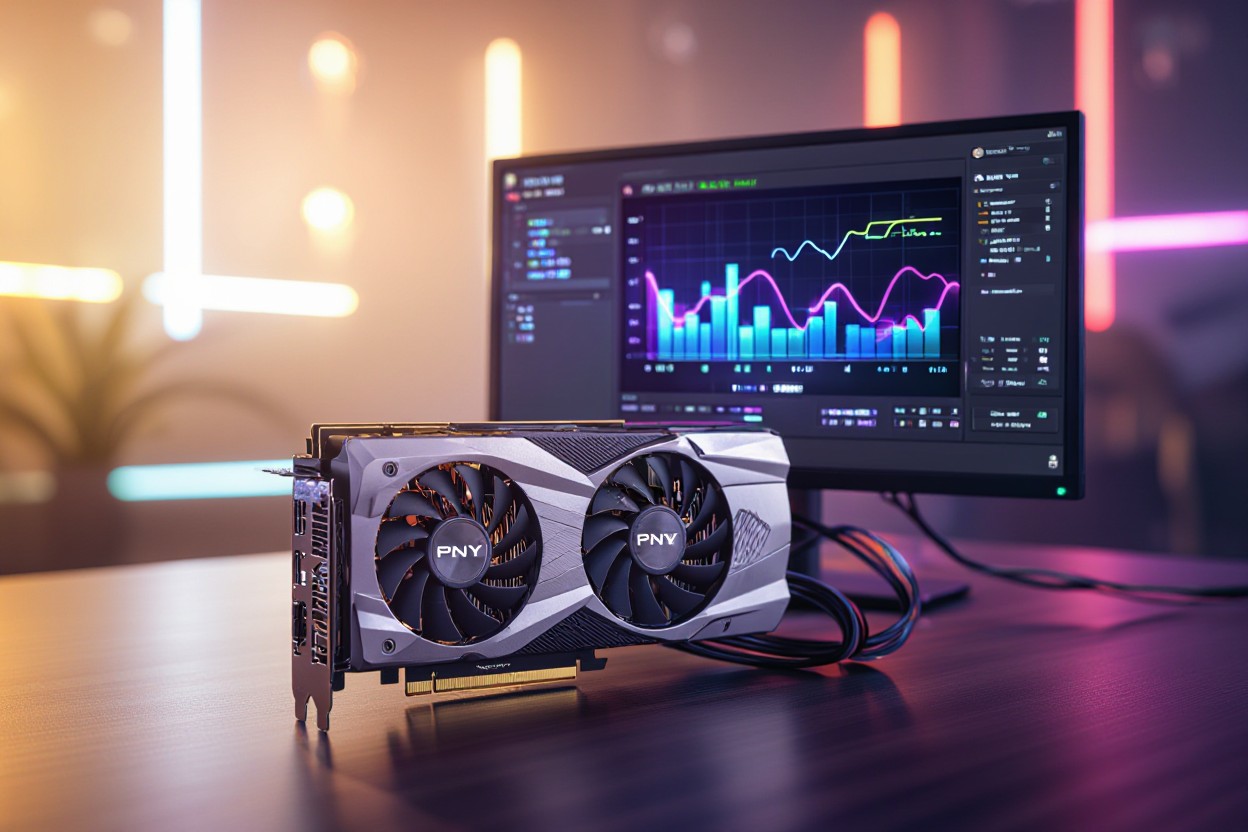
RAM Recommendations
Your RTX 6000 Ada Generation with its 48 GB VRAM demands adequate system memory to prevent data transfer bottlenecks during intensive workflows. Pairing this card with at least 64 GB of DDR4 or DDR5 RAM ensures smooth operation when handling large datasets, 3D rendering, or AI training tasks. For professional applications like 8K video editing or complex simulations, 128 GB provides optimal headroom and eliminates memory-related stuttering. You’ll notice that insufficient system RAM forces your GPU to wait for data, effectively wasting the card’s computational power and creating performance gaps that no amount of VRAM can compensate for.
Real-world Application Scenarios
Understanding bottleneck percentages becomes truly valuable when you apply them to your specific use cases. The RTX 6000 Ada Generation paired with a Threadripper 3990X demonstrates different characteristics depending on whether you’re gaming or running professional applications. At 1920 × 1080, you’ll encounter a 40.0% bottleneck, while 2560 × 1440 reduces this to 24.4%, making resolution selection critical for your workflow optimization. Your system’s behavior shifts dramatically between entertainment and production tasks, requiring different configuration strategies.
Gaming
Your gaming experience with this configuration will vary significantly by resolution and game type. CPU-heavy titles like simulations and strategy games will show the most pronounced bottleneck effects at 1080p, resulting in inconsistent frame rates despite the GPU’s massive capabilities. You’ll achieve better GPU utilization and smoother performance by moving to 1440p or 4K, where the graphics card can fully engage its 48 GB of VRAM and Ada Lovelace architecture. Competitive shooters and esports titles may still underutilize your GPU at lower resolutions.
Professional Workloads
Professional applications leverage your hardware differently than games, often benefiting from the Threadripper’s 64 cores and 128 threads working alongside the RTX 6000’s rendering capabilities. Your 3D rendering, CAD modeling, and AI training tasks will see minimal bottlenecking because these workloads distribute processing across both CPU and GPU simultaneously. Video editing at 8K resolution, ray-traced viewport rendering in Blender, and large-scale simulations utilize the 48 GB VRAM buffer effectively while the CPU handles encoding and scene management.
When you’re running complex professional workflows, the synergy between your processor and graphics card becomes even more apparent. Multi-application scenarios—such as simultaneously rendering in the background while editing in the foreground—benefit from the Threadripper’s exceptional core count, preventing the CPU bottleneck from impacting your GPU’s performance. Machine learning training with large datasets, architectural visualization with real-time ray tracing, and scientific computing applications will push both components to their limits without creating the same bottleneck issues you’d encounter in gaming. Your system excels particularly in tasks requiring sustained parallel processing, where the 280W TDP of the RTX 6000 Ada and the workstation-class stability of the Threadripper platform deliver consistent, reliable performance across extended rendering sessions.
Conclusion
With this in mind, understanding bottleneck calculations for your PNY VCNRTX6000ADA-PB RTX 6000 Ada Generation 48 GB helps you optimize your system’s performance. By analyzing how your processor and graphics card interact at different resolutions, you can make informed decisions about upgrades, settings adjustments, and resolution choices. Whether you’re experiencing CPU limitations at 1080p or seeking balanced performance at 1440p, these calculations provide the insights you need to maximize your hardware investment and achieve the smoothest possible gaming and professional workflow experience.
- NVIDIA RTX 6000 Ada Generation 48 GB Bottleneck Calculation - October 17, 2025
- Optimize Your GeForce RTX 5070 Performance with Our Bottleneck Tool - October 2, 2025
- GeForce RTX 5090 Bottleneck Calculator: Optimize Your Setup - October 1, 2025

